Paonias excaecatus
Paonias excaecatus, the blinded sphinx, is a moth of the family Sphingidae. The species was first described by James Edward Smith in 1797.
| Blinded sphinx | |
|---|---|
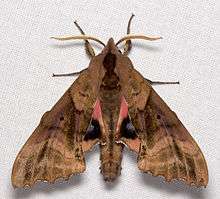 | |
| Scientific classification | |
| Kingdom: | Animalia |
| Phylum: | Arthropoda |
| Class: | Insecta |
| Order: | Lepidoptera |
| Family: | Sphingidae |
| Genus: | Paonias |
| Species: | P. excaecatus |
| Binomial name | |
| Paonias excaecatus (J. E. Smith, 1797)[1] | |
| Synonyms | |
| |
Distribution
It is found in Nova Scotia, New Brunswick and Prince Edward Island, and across the rest of Canada all the way to British Columbia. In the United States it ranges south to Florida in the east, and westward to eastern California and as far south as central Texas.
Description
The wingspan is 60–85 mm. Adult moths are nocturnal; after a brief bout of activity after dusk, they seem to prefer the later hours of the night.[2]
The eggs are greenish yellow and small. Hornworms hatch after about 8 days. Primary food sources for the larvae are deciduous trees such as willows, birch and cherries, as well as shrubberies, like ninebark and roses[3]. Like the rest of the family Sphingidae, they burrow shallowly into soil to pupate. Once they leave their pupa, the adults almost immediately mate. Adults do not feed.
Gallery
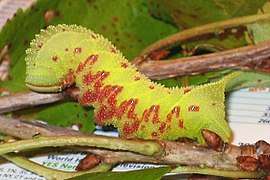 Caterpillar
Caterpillar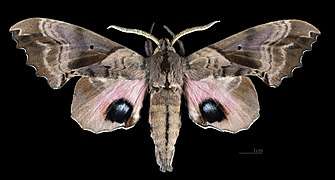 Male, dorsal view
Male, dorsal view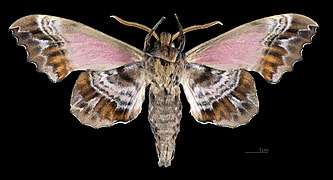 Male, ventral view
Male, ventral view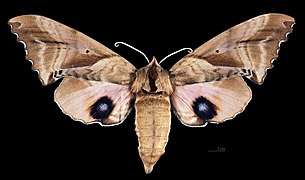 Female, dorsal view
Female, dorsal view Female, ventral view
Female, ventral view
References
- "CATE Creating a Taxonomic eScience - Sphingidae". Cate-sphingidae.org. Archived from the original on 2012-12-20. Retrieved 2011-11-01.
- Fullard, James H.; Napoleone, Nadia (2001). "Diel flight periodicity and the evolution of auditory defences in the Macrolepidoptera" (PDF). Animal Behaviour. 62 (2): 349–368. doi:10.1006/anbe.2001.1753. Archived from the original (PDF) on June 15, 2007.
- https://bugguide.net/node/view/4481
External links
- Oehlke, Bill "Paonias excaecatus, The Blinded Sphinx J. E. Smith, 1797" Sphingidae of Prince Edward Island. Archived May 13, 2006.